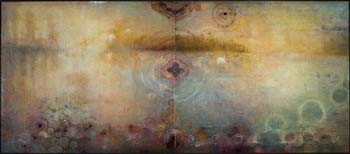
Marlana Stoddard Hayes '83 lives and works in West Linn, Ore., close to the Willamette River.
Her “Open Water” is inspired by the river, which, she says, “runs to the east of our house. We are on a ravine and look out over the river. The rising mists are so typical of this region and are beautifully romantic, with soft edges.”
In 1990, she was an artist-in-residence at the Sitka Center for Art and Ecology, and has had more than 14 grants and fellowships from the Kansas Arts Commission. Her work incorporates a cross-fielding knowledge system, which uses the combination of garden, library, lab and home as inspiration.
She has exhibited in France, Africa and China, as well as in more than 300 exhibitions in the United States. She has given invited lectures and presented papers at Stanford University and the University of Michigan, among others.
This past summer, a folio of paintings that explore the spore prints of the Agaricus agustus mushroom was featured in the journal Orion.
Her work is represented by Beppu art consultants in Portland, Ore. “My work,” she says, “is concerned with following the organic process and is not forced into being. I prefer the method of inviting chance and growth to occur over time and to follow its own path. The pieces are grown over a period of months. I hope to convey a depth of atmospheric space that cause a sensation of peace in the viewer.”
Deadheading Marigolds, Kansas, August 1988
By Vivien Minshull-Ford ’76
My hand firmly snaps off the heads,
scatters next year’s seeds
to come up who knows where.
I roll one faded bloom in my hand:
the pleasing skunk smell
opens a small crack in the past.
In Kenya once, a legendary giant’s hand
crushed a mountain like a marigold,
making four distinct hills, the Ngong.
With that scent on my fingers,
I see the hills again,
blue-mauve in the distance
above the dirt road that leads
to the Masai reserve.
Someone is calling my name
but I face the other way and shade my eyes,
swirling my left sandal in the dust,
a figure-of-eight
that peppers my white socks,
the ones kept for parties.
Brittle with the rain to come—
but not soon enough—
the air is broken by the husky voices of pigeons,
the faint rattle of the eucalyptus tree;
the skinny pie-dog scratches in its shade.
The flower beds have the thorny things I cannot grasp
among the pink and magenta cosmos,
the singing amber, saffron, orange
and the dried-blood tinted marigolds
of a herbaceous border
not far from the Equator.
“They’re the salt of the earth, the natives out here,”
says the settler’s old widow,
“but most people fail to realize it.”
Sitting among her chintz and Staffordshire,
she signals to her houseboy,
whose white-gloved hands then pour the Earl Grey,
his dark face expressionless beneath his fez.
Living the charmed life once more,
I sit quiet on the elephant-foot stool,
an iced cake on my tilted plate.
Above my head, where the ceiling ought to be,
there’s chicken-wire:
a rat skitters along a beam
into a dark corner.
And through the windows
the cosmos and the marigolds blaze
like a police siren on a still Midwestern afternoon,
brittle with the rain that will not come.
From the spring 1989 Mikrokosmos, Wichita State’s literary journal.





